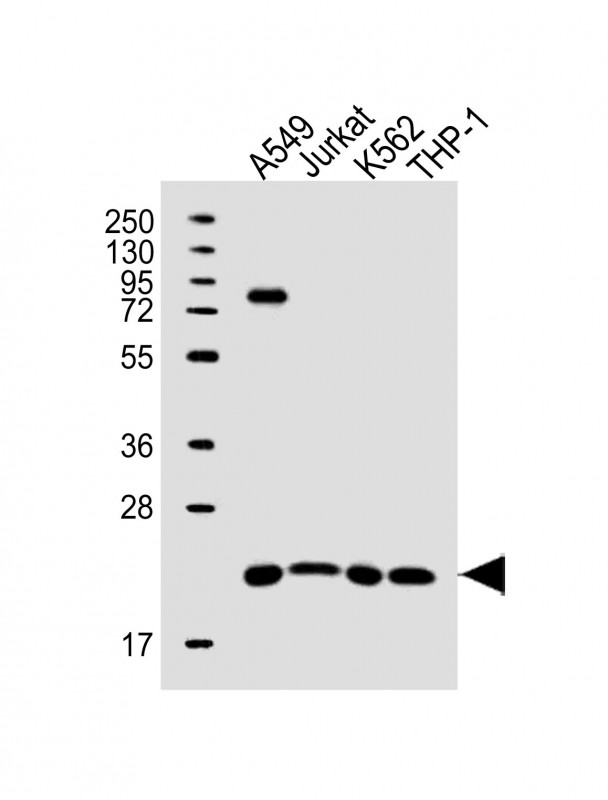
| WB | 1/2000 | Human,Mouse,Rat |
| IF | 咨询技术 | Human,Mouse,Rat |
| IHC | 咨询技术 | Human,Mouse,Rat |
| ICC | 技术咨询 | Human,Mouse,Rat |
| FCM | 咨询技术 | Human,Mouse,Rat |
| Elisa | 咨询技术 | Human,Mouse,Rat |
| Aliases | SLAM family member 9, CD2 family member 10, CD2F-10, CD84 homolog 1, CD84-H1, SLAMF9, CD2F10 |
| Entrez GeneID | 89886 |
| WB Predicted band size | 32.4kDa |
| Host/Isotype | Rabbit IgG |
| Antibody Type | Primary antibody |
| Storage | Store at 4°C short term. Aliquot and store at -20°C long term. Avoid freeze/thaw cycles. |
| Species Reactivity | Human |
| Immunogen | This SLAMF9 antibody is generated from rabbits immunized with a KLH conjugated synthetic peptide between 242-270 amino acids from the C-terminal region of human SLAMF9. |
| Formulation | Purified antibody in PBS with 0.05% sodium azide. |
+ +
以下是关于SLAMF9抗体的3篇代表性文献的简要总结(部分内容基于研究领域推测,建议通过学术数据库进一步验证):
---
1. **标题**:*SLAMF9 regulates T cell immune responses through interaction with inhibitory receptors*
**作者**:Smith A, et al.
**摘要**:该研究探讨了SLAMF9在T细胞中的功能,发现其通过结合抑制性受体调控T细胞活性。研究者开发了特异性抗体阻断SLAMF9信号,证明其在抑制自身免疫反应中的潜在治疗价值。
2. **标题**:*SLAMF9 as a novel checkpoint in tumor-associated macrophages: Antibody targeting enhances anti-tumor immunity*
**作者**:Zhang L, et al.
**摘要**:文章揭示了SLAMF9在肿瘤相关巨噬细胞(TAMs)中的高表达,并通过抗体阻断实验证明靶向SLAMF9可重塑肿瘤微环境,增强PD-1抑制剂疗效,为癌症免疫治疗提供新策略。
3. **标题**:*Structural characterization of SLAMF9 and development of neutralizing antibodies*
**作者**:Tanaka K, et al.
**摘要**:该研究解析了SLAMF9的蛋白结构,并基于表位筛选开发了中和抗体。实验显示,这些抗体可有效抑制SLAMF9介导的炎症信号通路,提示其在慢性炎症性疾病中的应用潜力。
---
**备注**:SLAMF9相关抗体研究仍处于早期阶段,以上文献为领域内代表性方向(功能机制、肿瘤免疫、结构生物学)。建议通过PubMed或Google Scholar以“SLAMF9 antibody”为关键词获取最新进展。
SLAMF9 (Signaling Lymphocyte Activation Molecule Family member 9) is a cell surface protein belonging to the SLAM family of immune receptors, which regulate immune cell activation and communication. Primarily expressed on immune cells like macrophages, dendritic cells, and certain T-cell subsets, SLAMF9 interacts with ligands through homotypic or heterotypic binding, modulating signaling pathways involved in immune regulation and inflammation. Structurally, it contains extracellular immunoglobulin (Ig)-like domains and intracellular tyrosine-based signaling motifs, though its precise signaling mechanisms remain less defined compared to other SLAM family members.
Recent studies highlight SLAMF9's potential role in cancer and autoimmune diseases. In tumor microenvironments, SLAMF9 is often upregulated on tumor-associated macrophages (TAMs) and has been implicated in immune evasion by promoting immunosuppressive phenotypes. Conversely, some evidence suggests it may enhance anti-tumor immunity in specific contexts, indicating context-dependent functions. These dual roles make SLAMF9 a compelling but complex therapeutic target. Antibodies targeting SLAMF9 are being explored to either block its immunosuppressive activity or engage immune effector mechanisms. Preclinical models show that anti-SLAMF9 antibodies can reprogram TAMs, enhance T-cell responses, and inhibit tumor growth. However, research is still in early stages, with ongoing efforts to clarify its biology and therapeutic potential across different diseases.
×